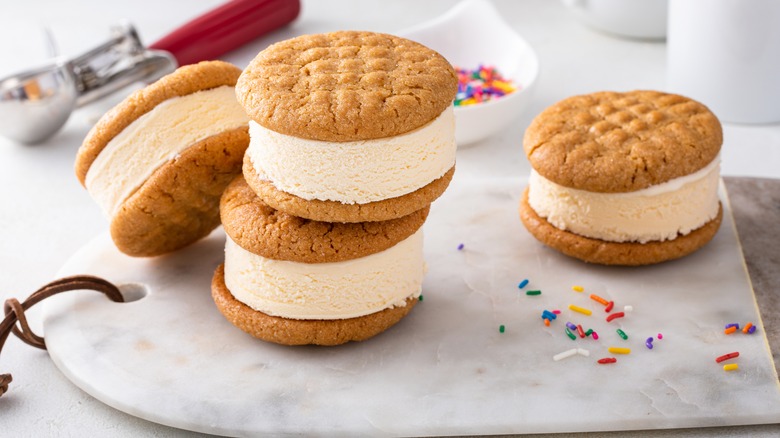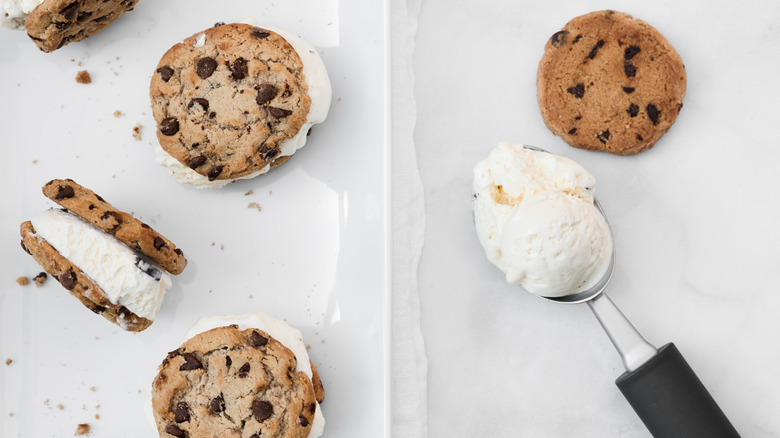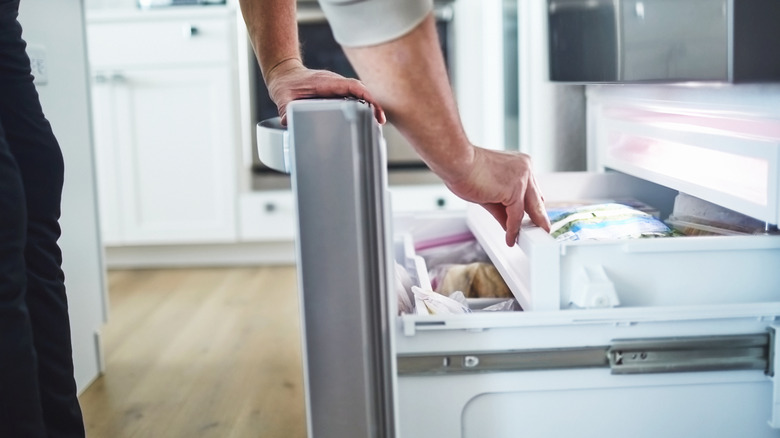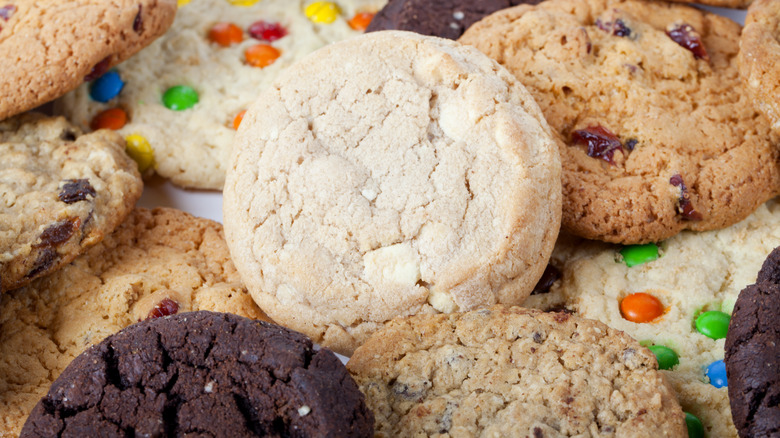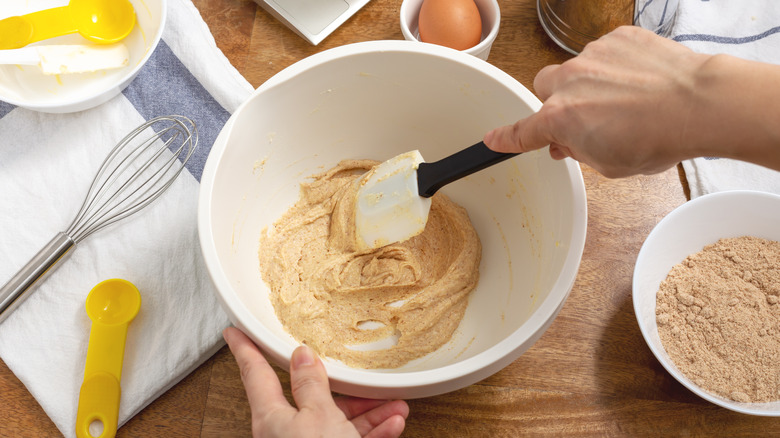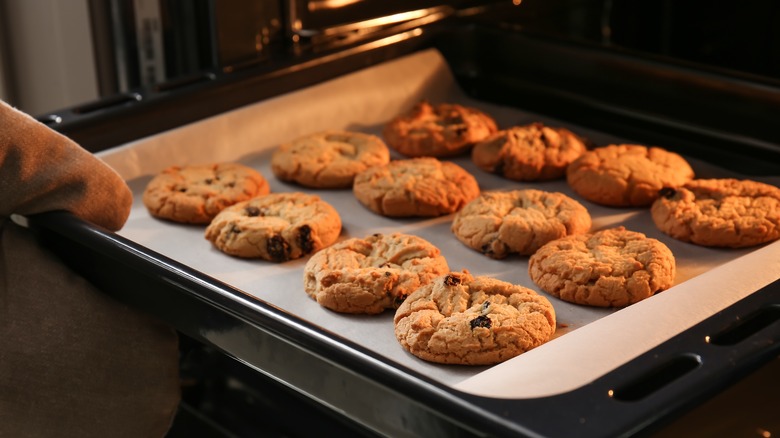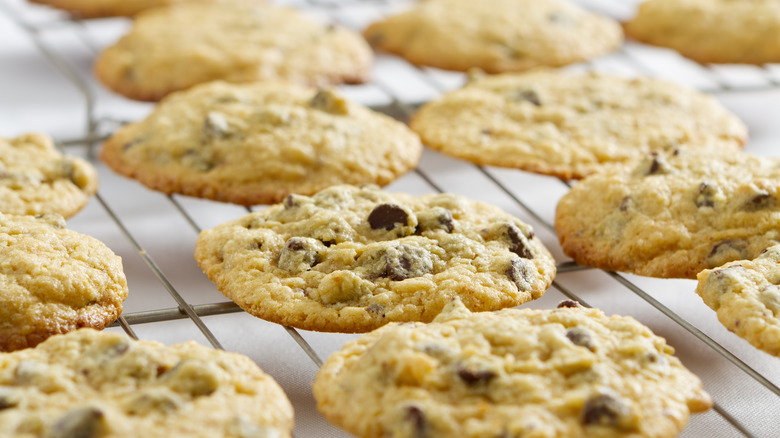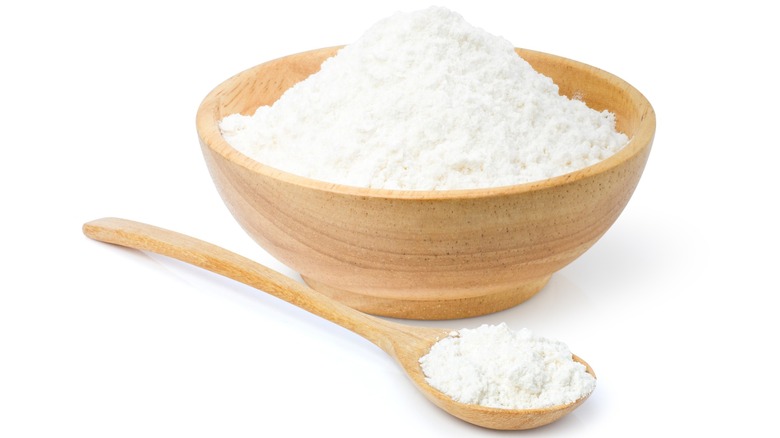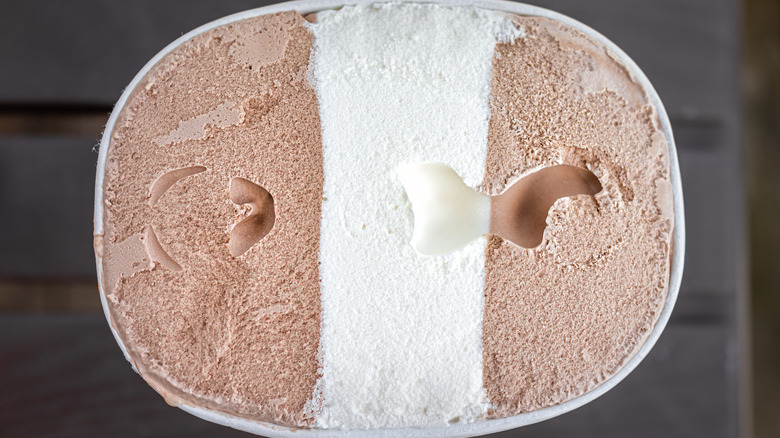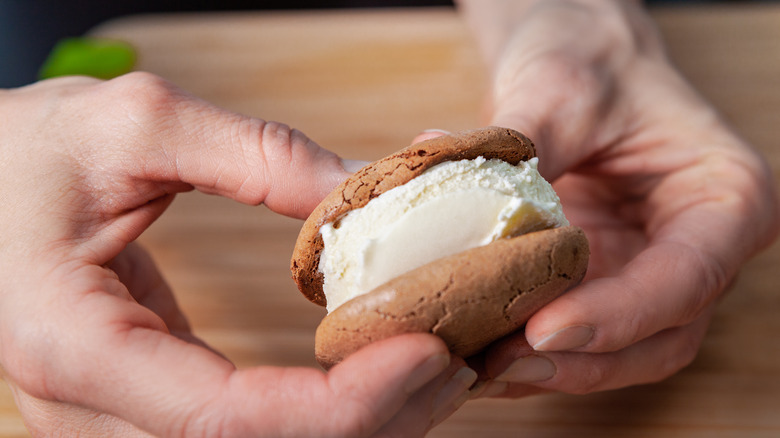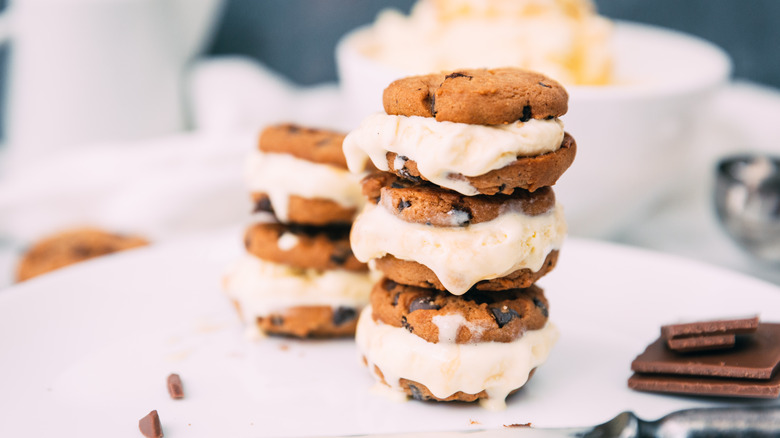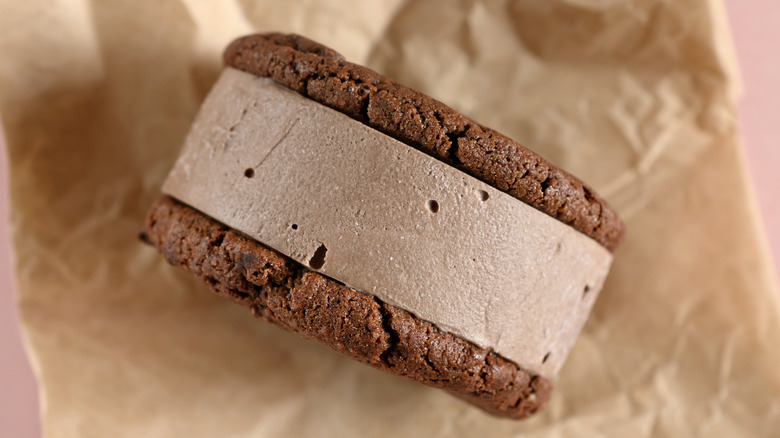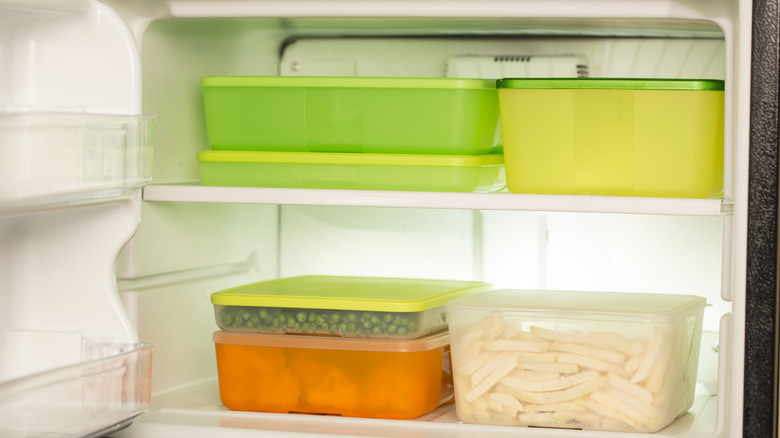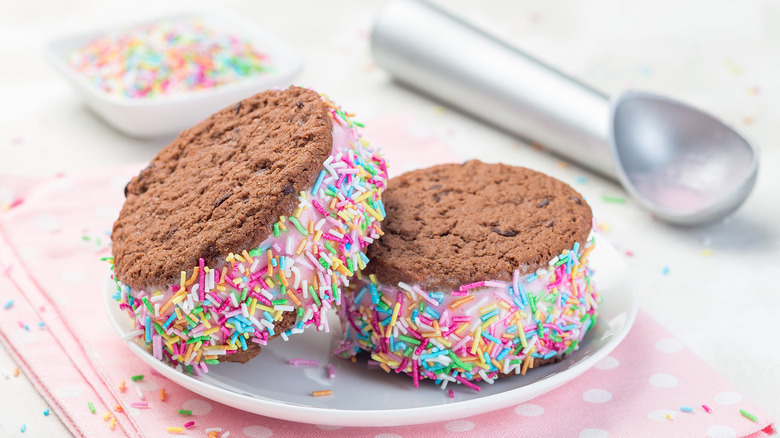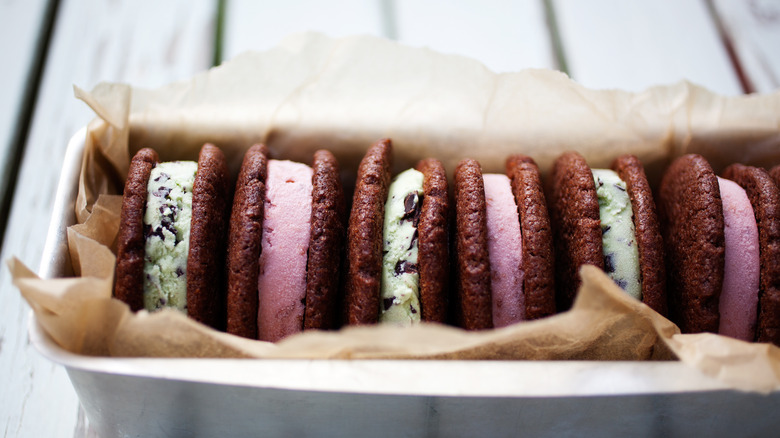14 Chef-Approved Tips For Making The Perfect Homemade Ice Cream Sandwich
If you've ever wondered what exactly goes into a perfectly crafted ice cream sandwich, I'm here to help you out. Maybe you've only ever had this sweet treat from the ice cream truck or the grocery store (you know, the kind with chocolate wafers so tacky that half of it ends up on your fingertips). Although those are delicious, I can give you some tips on how to make ice cream sandwiches that are 1,000 times better.
I first learned these ice cream sandwich-making techniques in culinary school. But later on, I perfected these methods while working at a fine dining hotel. We had them on the room service menu. You can only imagine how meticulous of a process it was to not only make such a delicate dessert, but to make it well enough that it could withstand transportation through a courtyard.
Obviously, the texture and flavor of a classic ice cream sandwich are just as important as the appearance and structure, so I'm here to give you pointers on the whole process. After reading these tips, you'll never want a store-bought ice cream sandwich again, because you'll be stocking your freezer with delectable homemade ones instead.
1. Use high-quality cookies and ice cream
Making an incredible ice cream sandwich takes some thought and preparation. First, you have to start with the best ingredients possible. Although it's easier to pick up a package of Chips Ahoy! cookies and call it a day, doing so will give you less-than-stellar results. Instead, put your heart fully into it and make the cookies from scratch. With homemade cookies, you have control over how they bake and freeze. You know exactly what ingredients are in them, and you can pull them from the oven at the right time.
And of course, it wouldn't be an ice cream sandwich without the ice cream, so this ingredient's quality is equally important. Luckily, you don't necessarily need to make it homemade (although you certainly can), but it's a wise idea to choose a reputable ice cream brand. So, let yourself splurge a bit here. Maybe pick a more expensive ice cream that you might typically skip over — something with minimal ingredients. Stay away from super artificial products with unnecessary filler ingredients. In the end, this makes a world of difference in the dessert's consistency and taste.
2. Clear some freezer space as preparation
One simple step that often gets overlooked during the ice cream sandwich preparation process is clearing space in the freezer. Unfortunately, if you accidentally bypass this measure, you might find yourself in a pickle. When you craft a perfect ice cream sandwich, you must freeze the cookies and the ice cream separately, as well as some of the tools. The last thing you want to do is scramble to make everything fit before the ice cream melts.
You'll also need space in the freezer for a medium to large bowl and for at least one tray of cookies, depending on how many sandwiches you make. Regarding tools, it's clever to freeze the spatulas and spoons you plan to use with the ice cream. This is especially true if you plan to add cookie crumbs or other mix-ins, because every second counts when working with the ice cream. By using chilled tools, you can slow the process of the ice cream melting while it is at room temperature, which is why using a chilled bowl is important too.
Of course, by making space, you don't need to actually remove any of your frozen goods from the freezer. Just take a few minutes to rearrange and organize your freezer space, fitting items together like a puzzle to create an area you can use temporarily while you work.
3. Be particular about the type of cookie you use
With ice cream sandwiches, you can't necessarily use any old recipe. This is because the cookie's texture, and how it holds up when you freeze it, will impact the success of your ice cream sandwich. To be particular, bulky or crispy cookies aren't suitable. You might understand this if you've ever bitten into an ice cream sandwich with a cookie that's hard to bite through. In the process, all the ice cream escapes out the sides.
There are two types of cookies that work best: chewy cookies or cake-like cookies. Some fantastic options include chocolate chip, oatmeal, or soft sugar cookies because these types of cookies — also known as "drop" cookies – make the best ice cream sandwiches. Also, if you have a specific type of cookie in mind, you can make slight modifications to the recipe to make it more appropriate. For example, sometimes peanut butter cookies are crunchy, but you can make certain ingredient swaps to set yourself up for success. On the other hand, some cookies are just unfit for the occasion, like gingersnaps or shortbread.
4. Make modifications to the recipe if needed
An important thing to consider is how temperature can affect a food's flavor. Some flavors can become muted in frozen food, and the last thing you want is for a dessert to taste bland. To combat this, I've found that increasing the amount of vanilla extract, or other flavoring agents, is a good idea for this treat. I also suggest swapping 25% to 50% of the sugar for either corn syrup or another type of invert sugar. When you bake cookies with invert sugar, the treats will have a mouthfeel and remain chewier after you freeze them, too.
If you don't want to use invert sugars, there are other ways to ensure the cookies stay pillowy. First, you can add an extra egg yolk for every egg the recipe calls for. Secondly, you can use canola oil or melted butter in place of softened butter. This, of course, changes the consistency of the dough, and the cookies spread out more, but that's actually desirable in this case.
5. Bake the cookies carefully
Baking the cookies with caution is important, whether you make a large cookie slab to cut or if you bake individual ones to use as the tops and bottoms. With either method, the thickness of the cookie matters. You don't want cookies that are paper thin, because they'll crack when you assemble the sandwiches. You also don't want them so large that you can't comfortably bite into them. Aim for cookies that are ½-inch to ¾-inch thick.
For individual cookies, I urge you to use a scoop so they are all uniform. Otherwise, when you go to build the sandwiches, the bottom cookie might be fine, but the lid might be too small (or vice versa), which can be quite messy. It also looks more pristine when the sandwich base pieces are exactly the same size.
Lastly, if there's one thing to be extra cautious of, it's to not over-bake them. In fact, slightly underbaking them is actually celebrated here. When you remove them from the oven just a minute or two early, they remain much softer when they cool, whereas over-baked cookies turn hard, and even more so when they freeze.
6. Give the cookies ample time to cool
After you take the cookies out of the oven, the first step is to let them cool to room temperature. You can transfer them from the hot pan to a cooling rack after they slightly firm up and hold their shape better. Then, once they no longer feel warm to the touch, move them again to a tray or platter. Place them in the freezer to further cool them. Although this might seem like overkill, it's actually not.
In the freezer, they become more solid and can hold the weight of the ice cream much more easily. Sadly, I learned this trick the hard way. In my early days of making ice cream sandwiches, I would try to squish two room-temperature cookies together with the ice cream in between. Consequently, the cookies would break right down the center. So, you can learn from my mistakes.
7. Add tapioca starch to homemade ice cream
If you decide on making the ice cream yourself, tapioca starch can assist in giving your homemade ice cream a better texture. This product is made with liquid drawn out from cassava plants. It is a binding and thickening agent that people use for both cooking and baking. People often use it in gluten-free recipes in place of flour. But in this case, it helps you produce luxuriously thick and smooth ice cream. Who wouldn't want an ice cream sandwich with a super creamy center?
To use it, add 1 to 2 tablespoons of tapioca starch in a recipe that makes 1 quart of ice cream. You can prevent lumps if you mix it with a small amount of liquid to make a slurry before you incorporate it into the other ingredients. This ingredient is ideal for recipes in which you cook the ice cream base on the stovetop before you churn it. Tapioca starch typically needs heat to properly work, unless you purchase a special kind.
8. Don't let the ice cream soften in the carton
Waiting for ice cream to soften in the carton and then scooping it onto the cookies isn't actually the best way to make this dessert. There is a much cleaner and more efficient way. When your cookies are cooling down, remove the carton from the freezer. Take a sharp knife and cut straight through the paper carton and ice cream, then chop it into pieces and transfer the pieces to a chilled, large bowl. Use a wooden spoon or whisk to manipulate the ice cream so it is spreadable. This procedure evenly softens it, as opposed to softening it in the carton. During the latter process, the sides melt first. While you're at it, you can add any mix-ins that you prefer.
Then make an ice cream slab by getting a parchment-lined sheet pan and evenly spreading the ice cream onto it, about ¾-inch thick. Tap the pan to even everything out, then pop it in the freezer. Later on, you can use a knife or cookie cutter to portion it out. For cookie slabs, you can spread the ice cream onto the bottom layer slab and add the top after it sets again.
9. Assemble the components with care
The assembly process for ice cream sandwiches is just as critical as the preparation. To make it go smoother, wait until the ice cream and cookies are roughly the same temperature. This way, there's a better chance of them properly sticking to each other. One thing I've learned firsthand is they might separate during storage if one is warmer than the other. Another factor is how you handle the pieces. Assuming that you've allowed the cookies to freeze, they should be somewhat sturdy. Yet, you should still be cautious with them.
When you place the ice cream in between the sandwich base pieces, you only need to gently press them together. It might be tempting to squish the pieces together, but this can cause breakage. If a cookie breaks, you might be able to use the ice cream as glue if you don't have any backups, but the presentation will suffer. So, it's best to avoid broken pieces in the first place. For cookie slabs, detach the whole piece and gently transfer it onto the ice cream-topped base. Return it to the freezer to set before you slice it.
10. Work quickly and in batches
No matter how many sandwiches you plan to make, you need to work quickly with this project, especially if your kitchen is on the warmer side. Remember, it's critical that you don't allow the ice cream to melt — even when you soften it. If it starts to become liquid at any point, even on the edges, throw it back in the freezer until it sets again.
I also suggest working in batches if you plan to make a large amount of ice cream sandwiches. This is especially necessary if you have a standard freezer, which might not have capacity for multiple trays at once. Plus, if you make a ton of sandwiches, it might be overwhelming to assemble them. For instance, if you need to make two dozen treats for a party, it's definitely easier to break the project down into batches of six or 12. This way, you don't have to race against the clock to the same extent. You can focus on the details more and ensure each sandwich comes out exactly how you want it.
11. Use precise cuts
For the most impressive ice cream sandwich possible, the filling should be the same size as the cookies. There are a couple ways to do this. If you're working with a frozen ice cream slab (as recommended), you can portion it out.
With round cookies, try to find a biscuit cutter that matches up well with the baked cookies. With rectangular or square ones, it's easy because you can use a ruler to be precise. To be safe, use a knife to score the rectangles before you actually cut it. You can dip the knife in hot water and then dry it with a towel in between each cut if you want super clean sides. The heat will help the knife glide through the ice cream. One by one, take the ice cream pieces and sandwich them with the cookies.
For cookie slabs, use a knife to cut rectangles or squares through the ice cream sandwich layers. For best results, trim the edges so every side looks polished.
12. After assembling them, freeze them overnight
Sure, you can eat your ice cream sandwich immediately after building it, but I suggest waiting it out. You've likely heard how some foods are better when the ingredients have had time to marry, and this is one of those cases. This isn't just an opinion — the cookies actually need time to rest and absorb some of the moisture from the ice cream. It's not such a dramatic change that the cookies will be soggy, but you will definitely notice a slight difference in the dessert's texture.
So, after you finish building the sandwiches, load them into a container with a lid and allow them to rest overnight. The next day, you can finally enjoy all the deliciousness they have to offer. If you don't plan on consuming them the next day, make sure to prepare them for long-term storage so they hold up well.
13. Experiment with flavors and decorations
Classic ice cream sandwiches usually have a plain chocolate or a chocolate chip cookie base with vanilla ice cream. However, who says you have to follow the norm? You can surely mix it up with different flavors. Some people even prefer to make their dessert sandwiches with brownies as the sandwich base. Honestly, you can follow the same tips when it comes to brownies, like modifying the recipe and slightly underbaking them.
In terms of the filling, experiment with different ice cream flavors like mint and chip, caramel, strawberry, or pistachio. Aside from the primary components, you can also decorate the sandwiches to take them up a notch. For instance, just after assembling them, roll the sides in sprinkles, chopped nuts, or chocolate flakes. Gently press them with your fingers after rolling them so they stick to the ice cream. You can also drizzle the sandwiches with melted dark or white chocolate to improve the presentation.
14. Store them correctly
Now that you've made superior ice cream sandwiches, don't destroy their quality by storing them in a careless way. Just because the ice cream is enveloped in a delicious cookie, that doesn't mean it is exempt from getting freezer burn. The same goes for the cookies (or any other ice cream sandwich base you use). In order to maintain their freshness, first, you can individually wrap them in parchment. Next, pile them all into an airtight container.
Technically, you can pop them in the freezer without the container, but the container gives them that extra layer of protection from cold air. It also prevents other items in the freezer from potentially smashing them when you start piling more things inside. Meanwhile, the parchment paper wrapping might remind you of the feeling you'd get when you used to unwrap ice cream sandwiches as a child. So, if you use parchment paper, you get the best of both worlds: nostalgia and a perfectly fresh ice cream sandwich.
